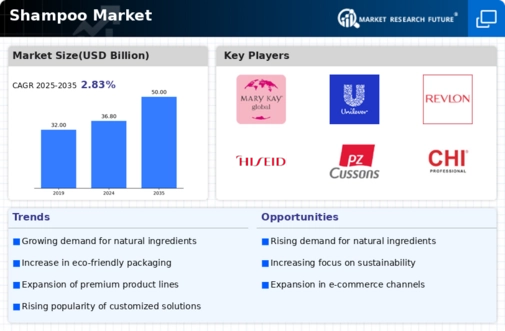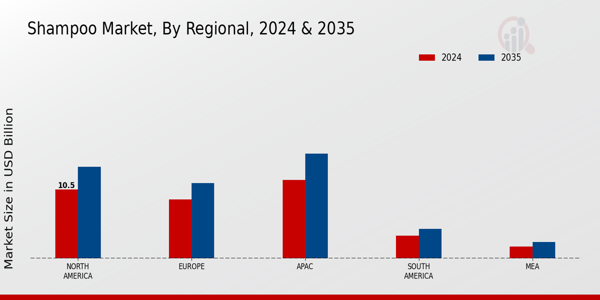Sustainability Trends
Sustainability emerges as a pivotal driver in the Global Shampoo Industry, as consumers increasingly seek eco-friendly and ethically sourced products. Brands are responding by reformulating their offerings to include biodegradable ingredients and sustainable packaging. This shift not only aligns with consumer preferences but also addresses environmental concerns. Companies that adopt sustainable practices may gain a competitive edge, appealing to a growing demographic that values corporate responsibility. As a result, the market is likely to witness a steady increase in demand for sustainable shampoos, contributing to the overall growth trajectory projected to reach 50 USD Billion by 2035.
Diverse Product Offerings
The Global Shampoo Industry benefits from a diverse range of product offerings that cater to various consumer needs. From organic and natural shampoos to specialized formulations for color-treated or curly hair, the variety ensures that consumers can find products that suit their specific requirements. This diversity not only enhances consumer choice but also drives competition among brands, leading to continuous innovation and improvement. As the market evolves, the introduction of new and unique products is expected to attract a wider customer base, further propelling the market's growth trajectory.
Influence of Social Media
The influence of social media significantly impacts the Global Shampoo Industry, as platforms like Instagram and TikTok shape consumer preferences and purchasing decisions. Influencers and beauty gurus often promote specific shampoo brands, creating trends that can lead to rapid spikes in demand. This digital marketing approach allows brands to reach a broader audience and engage with consumers directly. As a result, companies invest in social media campaigns to enhance brand visibility and attract new customers. The ongoing integration of social media into marketing strategies is likely to sustain growth in the market, contributing to the anticipated increase in market value.
Rising Consumer Awareness
The Global Shampoo Industry experiences a notable surge in consumer awareness regarding hair care products. As individuals increasingly prioritize personal grooming and hygiene, the demand for high-quality shampoos rises. This trend is particularly evident in urban areas where consumers are more informed about ingredients and their effects on hair health. The industry adapts by offering products that cater to specific needs, such as anti-dandruff or moisturizing formulas. This heightened awareness is projected to contribute to the market's growth, with the Global Shampoo Market expected to reach 36.8 USD Billion in 2024, reflecting a shift towards premium and specialized products.
Technological Advancements
Technological advancements play a crucial role in shaping the Global Shampoo Industry. Innovations in formulation and production processes enable manufacturers to create more effective and diverse products. For instance, the introduction of personalized shampoos, tailored to individual hair types and concerns, reflects a significant leap in product development. Additionally, advancements in packaging technology enhance user experience and product preservation. These innovations not only attract consumers but also drive market growth, as the Global Shampoo Market is expected to expand at a CAGR of 2.83% from 2025 to 2035, indicating a robust future for technologically enhanced hair care solutions.






















Leave a Comment